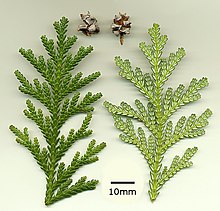Hiba tree of life
| Hiba tree of life | ||||||||||||
|---|---|---|---|---|---|---|---|---|---|---|---|---|

Hiba arborvitae ( Thujopsis dolabrata ), branch |
||||||||||||
| Systematics | ||||||||||||
|
||||||||||||
| Scientific name of the genus | ||||||||||||
| Thujopsis | ||||||||||||
| ( Thunb. Ex L. f. ) Sieb. & Zucc. | ||||||||||||
| Scientific name of the species | ||||||||||||
| Thujopsis dolabrata | ||||||||||||
| ( Thunb. Ex L. f. ) Sieb. & Zucc. |
The Hiba or thujopsis ( Thujopsis dolabrata , Jap .:翌檜, Asunaro or Aomori hiba ) is the only type of plant genus Thujopsis of the subfamily Cupressoideae in the family of the cypress family (Cupressaceae).
The Hiba tree of life is one of the "Five Trees of Kiso ", which were placed under nature protection in 1708 in the Owari fief .
description
Vegetative characteristics
The Hiba tree of life grows as an evergreen tree and reaches heights of 15 meters, on the British Isles up to 20 meters. He is very slow growing. The thin bark is gray or red-brown; it comes off in long strips. The crown is conical. The scaly leaves are 4 to 7 millimeters long and 1.5 to 2.2 millimeters wide; they are fresh green to yellowish green. The seedlings have two seed leaves ( cotyledons ).
Generative characteristics
The Hiba tree of life is single sexed ( monoecious ). The male cones are cylindrical and dark green. The female cones are almost spherical with a diameter of 1.0 to 1.6 centimeters, each with six to eight woody cone scales. Three to five winged, dark brown, elongated to oval seeds develop per fertile cone scale, they are 4 to 5 millimeters long and 3.0 to 3.5 millimeters wide. The pollen season is from January to March, and the seeds ripen in August to November of the same year.
Possibility of confusion
The Hiba tree of life looks very similar to the Thuja species , but differs from them by the round, woody cones, the winged seeds and the larger leaves.
distribution
Thujopsis dolabrata is native to Japan . He became known in Europe from around 1853. Over eighty percent of the natural population in Japan can be found in Aomori Prefecture , roughly evenly distributed in the mountains of the Shimokita and Tsugaru Peninsula .
Systematics
Since the botanical classification of this species was very controversial for a long time, there are many synonyms such as Thuja dolabrata L.f. , Platycladus dolabrata (Lf) Spach , Dolophyllum dolabratum and Libocedrus dolabrata (Lf) J. Nelson .
One can distinguish between two varieties:
- Thujopsis dolabrata var. Dolabrata (Syn .: Thujopsis dolabrata var. Australis A. Henry ): It occurs in southern and south-central Japan.
- Thujopsis dolabrata var. Hondae Makino : It occurs in northern and north-central Japan.
use
The wood is valued in construction for its resistance to fungal attack. The resistance is due to the hinokitiole (thujaplicin) contained in the wood . These are particularly effective against Daedalea dickinsii . In the Chūson-ji of Hiraizumi (Iwate) in 1962 three undamaged coffins made of this wood were found by members of the northern Fujiwara from the 12th century.
In Japan, the essential Hiba oil is extracted from the wood and the leaves .
Cultivated forms
- 'Nana': variety with a rounded, spreading habit with greenish, sometimes bronze-colored leaves. It becomes about 60 centimeters high and 150 centimeters wide.
- 'Variegata': In this form, the foliage is yellowish-white in color, but always turns back into the green form.
Individual evidence
- ↑ 木 曽 三 川 川 の 流 れ と 歴 史 の 歩 み 【木 曽 川 ・ 長 良 川 ・ 揖 斐川】 . 14. 木 曽 五 木 . (No longer available online.) In: 古 地理 調査 . Kokudo Chiriin , archived from the original on January 21, 2013 ; Retrieved December 19, 2012 (Japanese). Info: The archive link was inserted automatically and has not yet been checked. Please check the original and archive link according to the instructions and then remove this notice.
- ↑ a b Gordon Cheers (Ed.): Botanica: The ABC of plants. 10,000 species in text and images . Könemann Verlagsgesellschaft, 2003, ISBN 3-8331-1600-5 , p. 884 .
- ↑ a b c Rafaël Govaerts (Ed.): Thujopsis. In: World Checklist of Selected Plant Families (WCSP) - The Board of Trustees of the Royal Botanic Gardens, Kew . Accessed March 31, 2019.
- ^ Y. Inamori, Y. Morita et al .: The Excellence of Aomori Hiba (Hinokiasunaro) in Its Use as Building Materials of Buddhist Temples and Shinto Shrines. In: Biocontrol Science. Vol. 11 (2), 2006, pp. 49-54, doi : 10.4265 / bio.11.49 .
- ^ Robert Tisserand, Rodney Young: Essential Oil Safety. Second Edition, Churchill Livingstone, 2014, ISBN 978-0-443-06241-4 , pp. 301 f.
literature
- Colin Tudge : The secret life of trees , Penguin books, London 2006, ISBN 978-0-14-101293-3 .
- Christopher J. Earle: Datasheet at The Gymnosperm Database , 2007. (Eng.).
- Y. Inamori, Y. Morita et al .: The Excellence of Aomori Hiba (Hinokiasunaro) in Its Use as Building Materials of Buddhist Temples and Shinto Shrines. In: Biocontrol Science. Vol. 11 (2), 2006, pp. 49-54, doi : 10.4265 / bio.11.49 .
Web links
- Thomas Meyer: Data sheet with identification key and photos at Flora-de: Flora von Deutschland (old name of the website: Flowers in Swabia )
- Thujopsis dolabrata in the endangered Red List species the IUCN 2006. Posted by: Conifer Specialist Group, 1998. Retrieved on 12 May, 2006.






